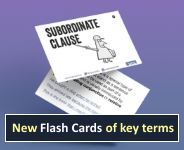Word structure: Inflection
Inflection is the process by which a single word takes different forms. For example, if we have the noun cat, we can add a plural ending to it to create cats. This is known as inflecting a noun and the ending we add is called a suffix.
What are the plural forms of the following nouns?
Welcome back!

Englicious is totally free for everyone to use!
But you will have to log in to see our library of teaching resources.
If you don’t have an account, that’s perfectly OK. You can register (for free).
It only takes a minute or two.
»
- Printer-friendly version
- Log in to view or leave comments

